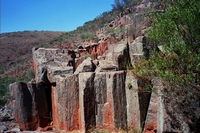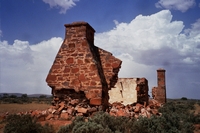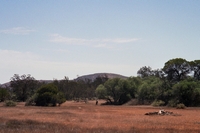Australia So Much to See


We head through pastoral stations to the Gawler Ranges in South Australia

At Iron Knob we left the
Thunder rumbled and the air became heavy. Would we be caught in rain? Confused by signage and unsure of what was
public road and what was a private station entrance, we took a wrong turn and found ourselves heading south, but it was on all roads
we hadnít seen before, so we continued, knowing we would reach the Eyre Highway.
At this point, with bushfires still fresh
in our minds, we saw lightening strike and start a fire on a hill top. Although the vegetation looked sparse, the fire continued
to burn down from the hill top. Fearing another bushfire disaster, and having no mobile phone reception, we drove to the nearest
station homestead, but found nobody there, nor at any of the cottages or outbuildings.
Not wanting to be trapped in an
unknown area by fire, or stranded should the looming thunderstorm bring drenching rain and flood the creek crossings, we continued
south. It made a very long day. With the thunder clouds closing in on us, we stopped only when we reached the end of the
pastoral stations, where the rural roads were better formed for all weather travelling. It had been nine long hours since we
started out that morning.
Next morning we reached the
One of the oldest
volcanic landscapes in the world,
One of
the animals they sometimes encounter in the
In the
It was very hot and humid so we used the generator
and air conditioner, and curious kangaroos that were resting in the shade under the trees came over to see us before hopping back
into the shade until dusk.
Thunder rolled all night and kept waking us. Only a few sprinkles of rain fell in each
shower. All night I was puzzled to hear the kangaroos walking on the sheets of corrugated iron that were lying on the ground. At first light, I could see why; they were licking up the sparse drops of rain as they fell.
Other places we visited included
the old shed and shearing quarters; now used as accommodation for groups. A small stone dam once provided water for station
livestock in this dry environment.
We drove in to see the ĎOrgan Pipesí; columns of volcanic rhyolite. This was
a challenging four wheel drive track to take with the caravan in tow, having steep dips and rises, soft patches, and overhung with
trees. When we reached the end of the track, it just stopped with nowhere to turn around. Leave your caravan behind
at the start of the four wheel drive track on re-entry into the park.
After a multi point turn, we were confident we could
head out, and no damage was done to the surrounding scrub while making this turn on the spot. A short walk took us to the impressive
columns of rocks which semi-surrounded us. This is one of two accessible rhyolite formations in this National Park; the other being
at


